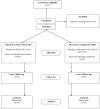Adopting a blended learning approach to teaching evidence based medicine: a mixed methods study
- PMID: 24341502
- PMCID: PMC3879412
- DOI: 10.1186/1472-6920-13-169
Adopting a blended learning approach to teaching evidence based medicine: a mixed methods study
Abstract
Background: Evidence Based Medicine (EBM) is a core unit delivered across many medical schools. Few studies have investigated the most effective method of teaching a course in EBM to medical students. The objective of this study was to identify whether a blended-learning approach to teaching EBM is more effective a didactic-based approach at increasing medical student competency in EBM.
Methods: A mixed-methods study was conducted consisting of a controlled trial and focus groups with second year graduate medical students. Students received the EBM course delivered using either a didactic approach (DID) to learning EBM or a blended-learning approach (BL). Student competency in EBM was assessed using the Berlin tool and a criterion-based assessment task, with student perceptions on the interventions assessed qualitatively.
Results: A total of 61 students (85.9%) participated in the study. Competency in EBM did not differ between the groups when assessed using the Berlin tool (p = 0.29). Students using the BL approach performed significantly better in one of the criterion-based assessment tasks (p = 0.01) and reported significantly higher self-perceived competence in critical appraisal skills. Qualitative analysis identified that students had a preference for the EBM course to be delivered using the BL approach.
Conclusions: Implementing a blended-learning approach to EBM teaching promotes greater student appreciation of EBM principles within the clinical setting. Integrating a variety of teaching modalities and approaches can increase student self-confidence and assist in bridging the gap between the theory and practice of EBM.
Figures
Similar articles
-
A randomised controlled trial of a blended learning education intervention for teaching evidence-based medicine.BMC Med Educ. 2015 Mar 10;15:39. doi: 10.1186/s12909-015-0321-6. BMC Med Educ. 2015. PMID: 25884717 Free PMC article. Clinical Trial.
-
Implementation of a blended learning approach to teaching evidence based practice: a protocol for a mixed methods study.BMC Med Educ. 2013 Dec 19;13:170. doi: 10.1186/1472-6920-13-170. BMC Med Educ. 2013. PMID: 24351113 Free PMC article. Clinical Trial.
-
Implementing a flipped classroom model in an evidence-based medicine curriculum for pre-clinical medical students: evaluating learning effectiveness through prospective propensity score-matched cohorts.BMC Med Educ. 2022 Mar 16;22(1):185. doi: 10.1186/s12909-022-03230-z. BMC Med Educ. 2022. PMID: 35296297 Free PMC article.
-
A hierarchy of effective teaching and learning to acquire competence in evidenced-based medicine.BMC Med Educ. 2006 Dec 15;6:59. doi: 10.1186/1472-6920-6-59. BMC Med Educ. 2006. PMID: 17173690 Free PMC article. Review.
-
Introduction of evidence-based medicine in undergraduate medical curriculum for development of professional competencies in medical students.Curr Opin Anaesthesiol. 2012 Dec;25(6):719-23. doi: 10.1097/ACO.0b013e32835a1112. Curr Opin Anaesthesiol. 2012. PMID: 23103843 Review.
Cited by
-
A randomised controlled trial of a blended learning education intervention for teaching evidence-based medicine.BMC Med Educ. 2015 Mar 10;15:39. doi: 10.1186/s12909-015-0321-6. BMC Med Educ. 2015. PMID: 25884717 Free PMC article. Clinical Trial.
-
Can blended learning and the flipped classroom improve student learning and satisfaction in Saudi Arabia?Int J Med Educ. 2016 Sep 4;7:281-5. doi: 10.5116/ijme.57a7.83d4. Int J Med Educ. 2016. PMID: 27591930 Free PMC article.
-
The effects of the flipped classroom in teaching evidence based nursing: A quasi-experimental study.PLoS One. 2019 Jan 15;14(1):e0210606. doi: 10.1371/journal.pone.0210606. eCollection 2019. PLoS One. 2019. PMID: 30645609 Free PMC article.
-
Piloting a blended-learning concept for integrating evidence-based medicine into the general practice clerkship.GMS J Med Educ. 2019 Nov 15;36(6):Doc71. doi: 10.3205/zma001279. eCollection 2019. GMS J Med Educ. 2019. PMID: 31844643 Free PMC article.
-
The integration of blended learning into an occupational therapy curriculum: a qualitative reflection.BMC Med Educ. 2017 Aug 17;17(1):135. doi: 10.1186/s12909-017-0977-1. BMC Med Educ. 2017. PMID: 28859649 Free PMC article.
References
-
- Straus S, Glasziou P, Richardson W, Haynes R. Evidence-based medicine. How to practice and teach it. Toronto: Churchill Livingstone Elsevier; 2011.
Publication types
MeSH terms
LinkOut - more resources
Full Text Sources
Other Literature Sources
Miscellaneous



